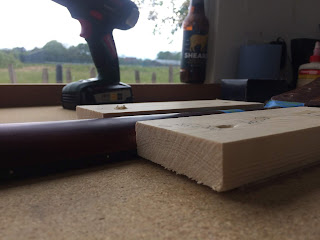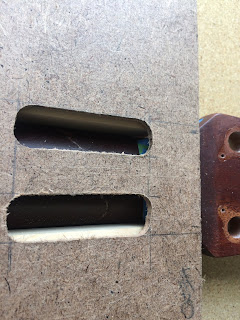Hmm, not quite. It was ready to take to the festival - just, although it really needed a couple more coats of oil.
The bigger issue was that it needs a good setting up as, unsurprisingly, the neck geometry has changed slightly while I have been doing the repair. I think the head has only moved forward by maybe 1mm but that has had quite a big effect on the action and playability, particularly when playing open chords. (Actually, it might have been like that before I had it, as it was already broken when I got it.)
I'm taking this as a positive as I can learn about setting up on what is still a fairly cheap guitar for me.
This photo doesn't really show how high the action is at the first fret, but it is at least 2mm when you fret at the third fret. From my research, that should be more like 0.5mm.
First I tweaked the truss rod to take a bit of bend out of the neck - the first time I have done that and it was quite a scary thing to do! A little adjustment goes a long way is what I found, but I have got it about right I think.
It is still quite high though and, again, research (aka Google / YouTube!) suggested that I needed to shave a bit off the nut height, so I tapped that off and sanded about 1mm off the bottom. It's a lot better, but I think it possibly still needs a little more taking off.
I was now getting some fret buzz but relieving a little tension on the truss rod stopped that. I'm pausing now to consider the next move, as I can't decide whether to shave some more off the nut or drop the bridge a little (I think the former, but need to work out which it should be, rather than blindly experimenting and getting it wrong).
It's playable now though and sounds pretty good for a £90 guitar (which it should, as all solid wood).




























































